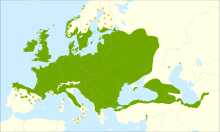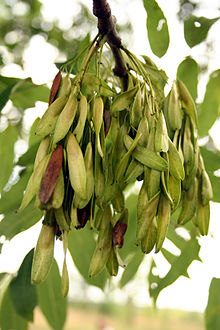Fraxinus excelsior
| European ash | |
|---|---|

| |
| Foliage and immature fruit | |
| Scientific classification | |
| Kingdom: | Plantae |
| Clade: | Tracheophytes |
| Clade: | Angiosperms |
| Clade: | Eudicots |
| Clade: | Asterids |
| Order: | Lamiales |
| Family: | Oleaceae |
| Genus: | Fraxinus |
| Species: | F. excelsior
|
| Binomial name | |
| Fraxinus excelsior | |

| |
| Distribution map | |
Fraxinus excelsior, known as the ash, or European ash or common ash to distinguish it from other types of
Description


It is a large
European ash rarely exceeds 250 years of age. However, there are numerous specimens estimated between 200 and 250 years old and there are a few over 250. The largest is in Clapton Court, England and is 9 m (29.5 ft) in girth. There are several examples over 4.5 metres (14.8 ft) in Derbyshire alone.
Distribution
Fraxinus excelsior is native to
It is native throughout Britain and Ireland, particularly on limestone, as in northern Scotland, where the most northerly native ashwood in Britain occurs on limestone at Rassal Ashwood.[13] It is widely planted elsewhere.[14]
Ecology
Ash occurs on a wide range of soil types, but is particularly associated with basic soils on calcareous substrates. The most northerly ashwood in Britain is on limestone at Rassal, Wester Ross, latitude 57.4278 N.[15] Ash prefers moister soil types and is commonly limited by temperature and so not found at the higher colder altitudes in much of Europe, though in Iran, it may reach 2000 m asl. As a young seedling, it is shade tolerant, but older trees are light-demanding. It is an early-succession species and may well outcompete beech and oak, which are later-succession species.[16]
F. excelsior mycorrhizae are of the internal arbuscular mycorrhizal type, in which the fungus grows within the tissues of the root and forms branched, tree-like structures within the cells of the root cortex. Unlike other Fraxinus species, F. excelsior does not form ectomycorrhizae.[2]
The
In Britain, 14
Ash dieback
Ash dieback is caused by the
Genome
The genome of Fraxinus excelsior is being sequenced by two groups of scientists in the United Kingdom. A group at
Uses


The resilience and rapid growth made it an important resource for smallholders and farmers. It was probably the most versatile wood in the countryside with wide-ranging uses. Until
Ash is an important constituent of
Ash is the only wood used for the manufacture of hurleys, referred to as hurls in parts of Leinster and known as a camán in Irish, the timber sticks used in the game of hurling in Ireland. Hurleys are manufactured from the butt log (bottom 1.5-m of the stem) and from trees ideally of a diameter at breast height around 25–30 cm. Only fast-grown, straight, and knot-free ash can be used for this purpose. Due to the lack of available ash in Ireland, over 75% of the timber needed to produce the 350,000 hurleys required for the game annually must be imported, mostly from Eastern European countries.[33] The importance of ash timber to the game of hurling is reflected in the fact that the game is referred to all over Ireland as "The Clash of the Ash".
Ash is valuable as firewood because it burns well even when 'green' (freshly cut).[34] Ash bark and leaves are used in modern herbal medicine for its astringent and laxative properties.[35]
Mythology
In the 13th-century Edda and other writing relating to Norse mythology, the vast ash tree Yggdrasil ("the steed (gallows) of Odin"), watered by three magical springs, serves as axis mundi, sustaining the nine worlds of the cosmos in its roots and branches.[36]
Folklore
On the Isle of Bute in Scotland, lovers reportedly used to eat leaves of an ash tree known as the "Dreamin' Tree" that grew near the church of St Blane, and the pleasant dreams they then experienced revealed their actual spouses and intended fates.[37]
Cultivars

Its many cultivars include;
- Fraxinus excelsior 'Aurea', the traditional, slow-growing golden ash ─ not to be confused with 'Jaspidea'
- Fraxinus excelsior 'Aurea Pendula' (weeping golden ash)
- Fraxinus excelsior 'Autumn Blaze'
- Fraxinus excelsior 'Autumn Purple'
- Fraxinus excelsior 'Crispa'
- Fraxinus excelsior 'Diversifolia' (one-leaved ash)
- Fraxinus excelsior 'Erosa'
- Fraxinus excelsior 'Jaspidea' a modern, vigorous golden ash
- Fraxinus excelsior 'Monophylla'
- Fraxinus excelsior 'Nana'
- Fraxinus excelsior 'Pendula' (weeping ash), one of the best-known cultivars, widely planted during the Victorian era, grows vigorously forming an attractive small to medium-sized tree with mounds of weeping branches
- Fraxinus excelsior 'Skyline'
Gallery
-
Two ash trees fused together
-
Tree 46 m tall, Château des princes de Croÿ, Le Roeulx, Belgium
-
Old tree, Belgium
-
Leaf and shoot, showing black bud
-
Weeping ash Fraxinus excelsior 'Pendula', Knightshayes Court, England
-
Buds
-
Bark
References
- . Retrieved 12 November 2021.
- ^ S2CID 86930831.
- ^ ISBN 0-00-220013-9.
- ^ a b Den virtuella floran: Fraxinus excelsior distribution
- ^ "Fraxinus excelsior L." Plants of the World Online. Royal Botanic Gardens, Kew. Retrieved 13 July 2023.
- ^ Kew World Checklist of Selected Plant Families, Fraxinus excelsior
- ^ Biota of North America Program, Fraxinus excelsior
- ^ Altervista Flora of the United States and Canada, Fraxinus excelsior
- ISBN 0-7523-0027 X
- ISBN 0-00-212035-6
- ISBN 0-00-219037-0
- ISBN 9780117100398.
- ^ ISBN 978-1853973864.
- ^ "Online atlas of the British and Irish Flora, Fraxinus excelsior (Ash)". Biological Records Centre and Botanical Society of Britain and Ireland. Archived from the original on 1 December 2021.
- ^ "Wood Pasture: Rassal Ashwood National Nature Reserve". Scottish Natural Heritage. Archived from the original on 6 September 2013.
- .
- ISBN 978-1-908213-14-3.
- ^ Alan Stubbs. "Invertebrates associated with Ash" (PDF). Archived from the original (PDF) on 3 September 2013. Retrieved 28 February 2015.
- ^ "Centre-barred Sallow Atethmia centrago". UKmoths. Retrieved 28 July 2017.
- ^ "15.014 Gracillaria syringella (Fabricius, 1794)". British leafminers. Retrieved 28 July 2017.
- ISBN 978-1-85153-284-1.
- S2CID 85292870.
- PMID 25568043.
- PMID 20823903.
- ^ Pliūra A, Lygis V, Suchockas V, Bartkevičius E (2011). "Performance of twenty four European Fraxinus excelsior populations in three Lithuanian progeny trials with a special emphasis on resistance to Chlara fraxinea". Baltic Forestry. 17 (1): 17–34. Archived from the original on 2 April 2015.
- S2CID 218618105.
- ^ "Welcome to Ash tree genomes – Ash Tree Genomes". ashgenome.org.
- ^ Heap, Tom (16 June 2013). "Ash genome reveals fungus resistance". BBC News.
- ISBN 1-85619-377-2.
- ^ "Ash". Niche Timbers. Retrieved 19 August 2009.
- ^ Petrică Tudor M, Ingrid Agnes M, Szilard B. 2011. Study of Physical Characteristics, Mechanical and Technological Properties of Wood Species from the Fraxinus Genus Encountered in Romania Compared to Other Main Forestry Species. Natural Resources and Sustainable Development [1].
- ISBN 1-85149-023-X.
- ^ John Whiriskey; Paul McCarthy, eds. (May 2006). Ash For Hurleys (PDF) (Report). Fact Sheet No. 35. Teagasc – The Agriculture and Food Development Authority. Archived from the original (PDF) on 22 November 2007.
- ^ "The burning properties of wood" (PDF). The Scout Association. 1999. Archived from the original (PDF) on 23 December 2012. Retrieved 1 November 2010.
- EUFORGEN.
- ISBN 978-0-85991-513-7.
- ^ Downie, R. Angus (1934). Bute and the Cumbraes Glasgow & London: Blackwood & Son Ltd. p. 83
External links
- Fraxinus excelsior – distribution map, genetic conservation units and related resources. European Forest Genetic Resources Programme (EUFORGEN)
- Fraxinus excelsior – Ash info, images and video at Woodland Trust










